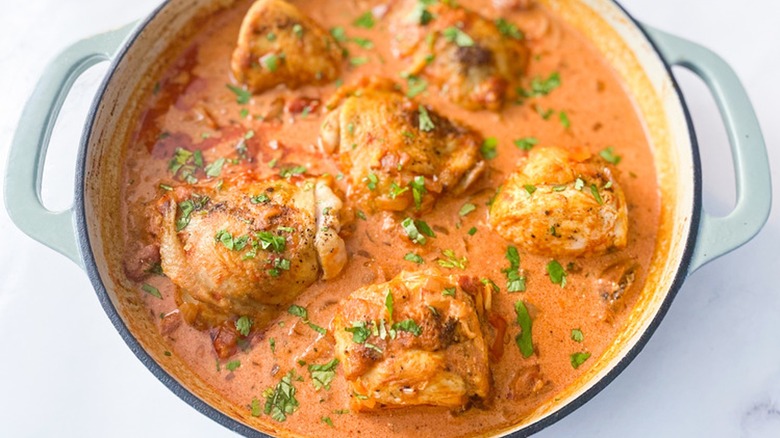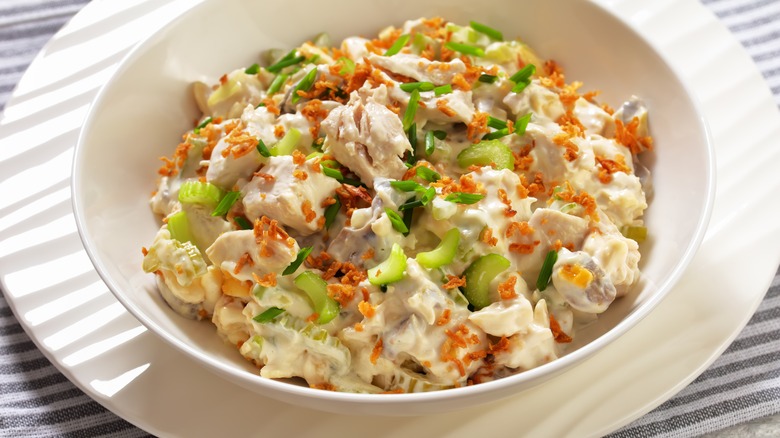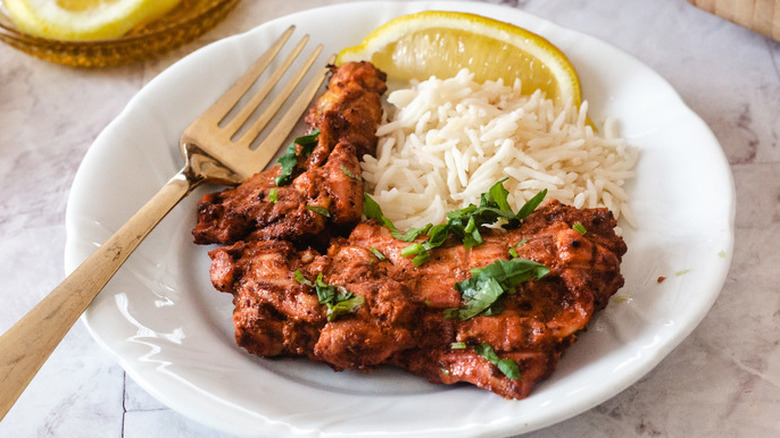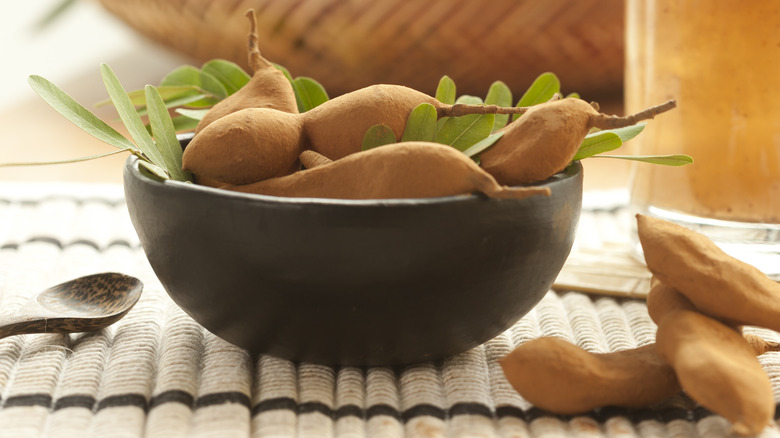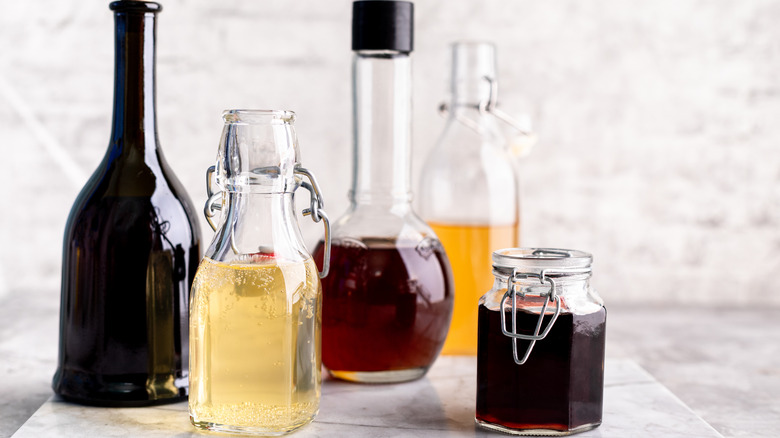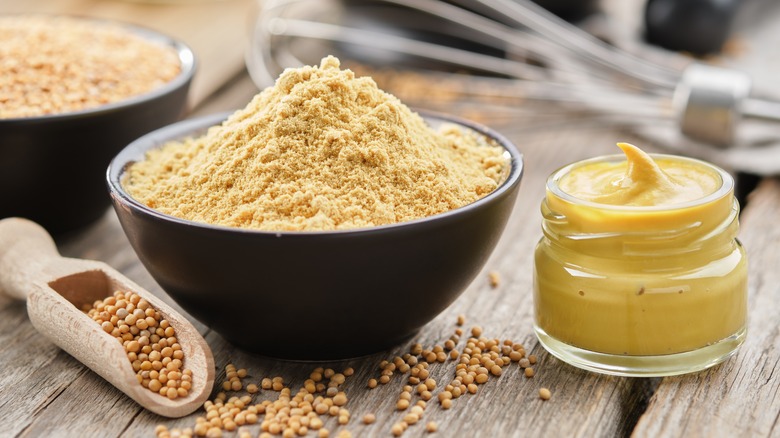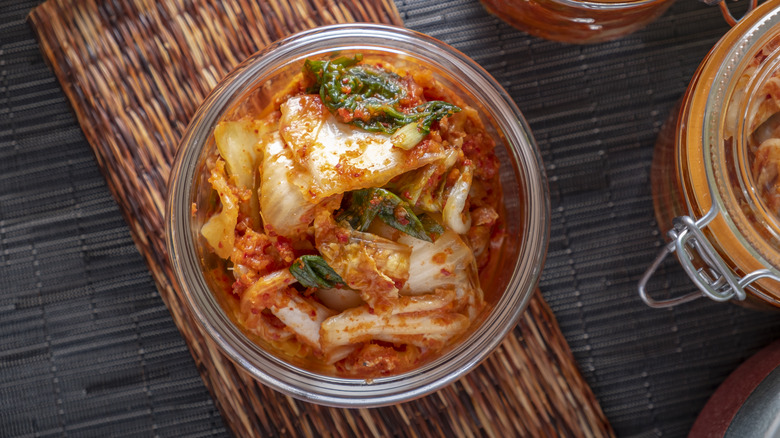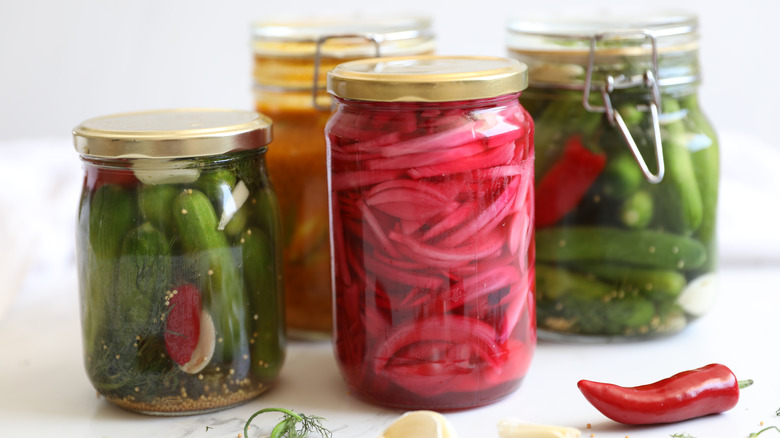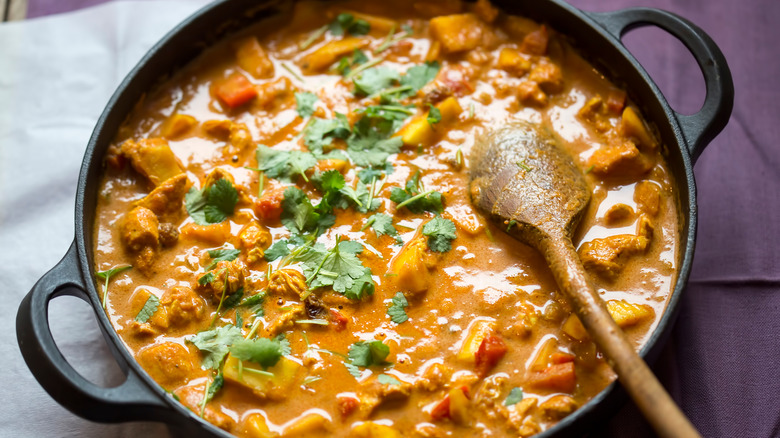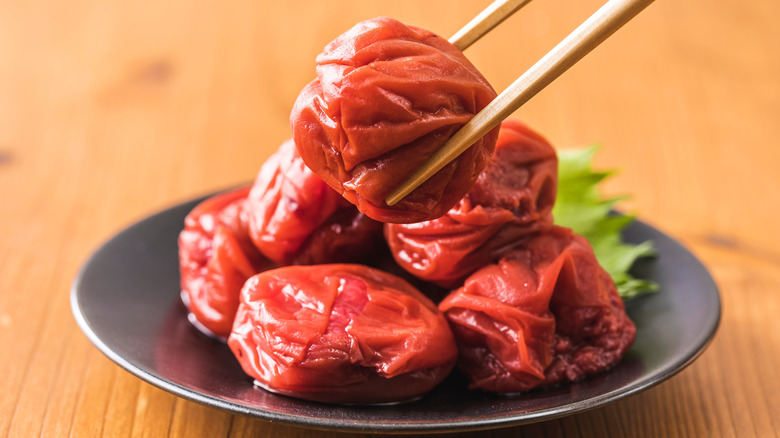All The Ways To Add A Touch Of Sour To Your Chicken
Chances are that if you liked the sour flavor you experienced in one chicken dish, you're looking for ways to recreate that tart and tangy zing with other ingredients. The sour flavor that you're seeking comes down to one thing: acid. Your options for adding sour flavors include marinating your chicken in an acid, using an acidic ingredient during the cooking process, or topping it with something acidic. Marinating your chicken in acidic ingredients not only gives it a nice, zesty flavor but helps tenderize the chicken as well.
Author of "Salt, Fat, Acid, Heat," Samin Nosrat told Splendid Table, "What acidity offers is a second taste to bounce that first thing off of. Whether it's salty and sour, or sweet and sour, or even rich and sour — like fatty and sour. If something is balanced properly, then all of a sudden all of these other parts of flavor become available to us." So, if you're looking for lip-smacking ingredients to use to take your chicken to the next level, try adding one (or even several) of these sour ingredients the next time you cook chicken.
Citrus
Using citrus with chicken is a fantastic way to add bright, tangy flavors to your dishes. The sour flavors we detect in citrus come from hydrogen. The more hydrogen ions a piece of citrus has, the more it lowers the fruit's pH level, making it even more acidic. You can choose from sweeter, citrus with less citric acid like orange and grapefruit, or venture into using ones like lemon or lime that are more sour than sweet. There are also some lesser-known citrus fruits you could use, like calamansi, kumquats, sour oranges, and pomelos.
Citrus makes excellent marinades, and you can cook with the juice or the whole fruit. The peel or the zest contains oils that can give it an even more powerful zing than the juice alone. Citrus is great as a glaze, to add to chicken salad, and for a pop of acidity in chicken stir-fries. Citrus is popular both to create roasted chicken or in skillet dishes with delicious citrus-inspired sauces. Lemon chicken is luscious with sourness, while dishes like orange chicken also contain a pleasant level of sweetness. So, play around with different citrus fruits to see which you like best.
Sour Cream
Sour cream is a delicious and versatile way to add flavor, moisture, and a creamy texture to chicken dishes. Sour cream actually starts out as the type of cream that you might use to make whipped cream. However, dairy experts add lactic acid and keep the cream at room temperature until the proteins thicken and it becomes wonderfully sour. Sour cream makes fabulously rich and tangy sauces because it combines both fat and acid. The fat content and the sweet flavor it gets from cooking are among the elements that make sour cream so tasty, so opting for full-fat sour cream and using it in a cooked dish brings together acidic, fat, and sweet flavors to delight your taste buds.
You can use sour cream as a marinade to help tenderize chicken, or as a binder to help keep coatings like breadcrumbs on chicken for baking or frying. You're also likely to love it in dishes that sour cream in the sauce, like chicken paprikash. It's even delicious as a topping for cooked chicken, as you may have experienced already from adding it as a condiment for a chicken taco. You may also consider using it instead of mayo for chicken salad.
Yogurt
Like sour cream, yogurt imbues chicken with a mild tanginess, moisture, and tenderness. Rather than adding lactic acid to yogurt, yogurt creates its own lactic acid as it ferments, and its live bacteria breaks down milk sugars. If you like a less-tart yogurt for breakfast, you might seek out a more tart variety for making chicken sour, like Greek or Bulgarian yogurt. Choosing a full-fat version will make your dish even more flavorful as the acid contrasts with the fat.
Yogurt makes a delicious marinade, which you'll find in dishes like Tandoori chicken. It's delicious in sauces and is especially popular in Indian cuisine like curries. Yogurt is the base for tzatziki sauce, which pairs well with Mediterranean grilled chicken dishes like kebabs, which can also be marinated in yogurt. It also makes an excellent binder for adhering crust ingredients like panko crumbs to chicken for frying or baking. Just like with sour cream, you can add yogurt to chicken salad instead of mayo for a tangy twist.
Sumac
Sumac is a fantastic way to introduce a unique and zesty flavor to your chicken dishes. Sumac comes from the dried berry of the sumac plant, which you may have encountered on hikes without even realizing it. While you can forage for it, it's also possible to buy it as a spice. The skin contains malic and citric acid, which is key to its tartness. Humans have likely been using sumac to add a sour punch to foods since we discovered it. It shows up in Native American cooking as well as ancient Mediterranean dishes, and was a source for adding sour flavors to foods for cooks without access to citrus fruits. The taste is similar to lemon, with unique almost floral muskiness. Interestingly, it contains an enzyme that makes it useful for tenderizing meat like chicken.
In the Middle East, it's common to find sumac as a barbecue or grilled chicken seasoning. It's the source of lip-smacking goodness in the classic Palestinian roast chicken dish called mussakhan. Sumac is also excellent for providing an infusion of tanginess for dry rubs and marinades.
Tajín
Adding Tajín seasoning to chicken is an exciting way to infuse it with a vibrant and sharp flavor burst. Tajín is a Mexican seasoning that combines the spiciness of chili peppers with salt and the acidic bite of citric acid and dehydrated lime juice. While Tajín has been around since 1985 and was first exported from Mexico to the U.S. in 1993, it didn't start to become more universally popular and available until the 2010s and 2020s. The salt, heat, and acidity of Tajín make it the perfect way to add an unexpected flavor punch to your chicken.
There are a lot of ways you can use Tajín to enhance your chicken dishes. The most simple way to use it is just by sprinkling it on your chicken or using it as a dry rub. It works well with other ingredients to provide chicken marinades with a sour twist. If you're not quite sure when the flavor combination might be appropriate, start by sprinkling it on Mexican chicken dishes like chicken enchiladas or chicken tacos, where it will instantly kick the flavor up a notch.
Tamarind
Tamarind can introduce a tangy, sweet, and slightly sour flavor to chicken. Tamarind is a "fruit" from the legume family. While it's native to tropical areas of Africa, it has become popular in cuisine in lands as far away as India and Mexico. You can use the unripe or ripe fruit or buy it as a concentrated paste or powder for adding tartness to foods like chicken. The riper it is, the more sweetness there is to go with the tart acidity of the fruit. It gets its distinctive sour flavor from citric acid and tartaric acid, which also turns it into an excellent meat tenderizer.
Its meat-tenderizing effects mean you can use tamarind in chicken marinades. It's also useful to add a bit of zest to chicken curries or as the base for chicken pad Thai. However, it's not uncommon to tame its sourness with a creamy ingredient like coconut milk. You can also use it as a glaze for grilled or roast chicken and as a tangy additive to barbecue sauce when making barbecue chicken.
Vinegar
Using vinegar with chicken can add sourness and depth of flavor to your dishes. The vinegar fermentation process creates acetic acid, which is what turns ordinary liquids like wine or apple juice sour. Every vinegar type has a distinctive flavor profile that can influence the taste of your chicken in different ways. For example, some vinegars like apple cider vinegar, balsamic vinegar, and wine vinegars have sweeter flavor notes. Meanwhile, sherry vinegar and beer vinegar have nutty taste attributes. So, it's important to know your vinegar before you decide which one to use.
Vinegar is useful in chicken marinades, glazes, sauces, and as a salad drizzle. Like other acids, vinegar helps soften chicken if you use it as a marinade. However, you'll want to combine it with other ingredients to help balance the acidity to prevent the chicken from tasting overly sour. One way to balance the vinegar in a marinade or other dish is by adding sweet ingredients like fruit or sugar. Another is to add fat like olive oil to the chicken dish, much like you add it to oil and vinegar salad dressing.
Sweet and sour sauce
Using sweet and sour sauce with chicken contrasts tangy acids with sugary ingredients for a well-balanced flavor experience. Nobody is sure whether sweet and sour sauce originated in Hunan or Guangdong, China, first (or at the same time). However, the first cooks who used sweet and sour sauce likely combined vinegar with fruits like pears or pineapples to make the sauce. Once Chinese restaurants in the U.S. started making the sauce, they changed up the ingredients both to entice American taste buds, and likely due to the cost or scarcity of traditional ingredients. Modern sweet and sour sauce recipes include sweet acidic ingredients like pineapple juice and ketchup, along with ingredients like rice vinegar and brown sugar. Pineapples get their acidity from citric acid, while ketchup gets its acidity from the acetic acid in vinegar and the citric and malic acid in tomatoes.
Sweet and sour sauce works well with fried chicken, kebabs, stir-fries, and even sheet pan chicken recipes. You can also use sweet and sour sauce in chicken salad, as a condiment for chicken sandwiches or wraps, and as a dipping sauce.
Mustard
Mustard provides a distinctive tangy and savory kick for chicken dishes. Mustard seeds themselves are slightly acidic, containing seven different types of acid. However, a lot of prepared mustards also include vinegar or tart verjus (unripe grape juice full of tartaric acid), making the condiment even tangier than it would be on its own. Mustard comes in a variety of condiment styles, which all have distinctive flavors to lend to chicken dishes. Since some are more intense or may even have a bit of spicy heat, it's a good idea to use the right mustard for the dish.
Prepared mustard can be the base for tangy marinades, glazes (when combined with something sweet like honey), and roast chicken. We like the zippy punch it provides for the filling of chicken cordon bleu. It's also a rich addition to sauces for pan-cooked chicken. However, you don't necessarily have to cook with it since it works well in chicken salad and as a condiment for chicken-based sandwiches.
Fermented vegetables
Fermented vegetables like sauerkraut and kimchi add a unique and complex flavor to chicken dishes. To jump-start the fermentation process, fermented vegetable producers add Bacillus bacteria, which react with the sugars in the vegetables to produce lactic acid. Some fermented veggies get an extra layer of acid with the addition of vinegar. When you add fermented vegetables to chicken, the results are fantastically umami and sour. However, be sure to keep in mind that fermented vegetables have a very strong and somewhat funky flavor that can be overwhelming if you don't add a balanced amount of them to the dish.
Some options for adding fermented vegetables to chicken include baking chicken with sauerkraut, making a sauerkraut chicken casserole, creating a chicken Reuben sandwich with sauerkraut, or even cooking the chicken and sauerkraut with sausages. Kimchi works with chicken as a stir-fry, skillet dish, or braised. You could even make fried rice with chicken and kimchi.
Buttermilk
Using buttermilk with chicken is an excellent way to achieve juicy, flavorful chicken with a pleasing tang. Buttermilk is a fermented dairy product, which contains lactic acid. Bacterial cultures added to buttermilk start to ferment the sugars in the milk, creating lactic acid. It's this acid that gives buttermilk its distinctive sour flavor. It's also lactic acid that helps buttermilk to be so successful in tenderizing chicken. Marinating chicken in a buttermilk brine combines acid and salt, which makes the chicken moist, tender, and deeply seasoned. It also helps give it a burst of flavor.
Buttermilk is an excellent marinade not only for fried chicken (its most popular incarnation), but also for grilled or baked chicken, kebabs, wings, and tenders. Buttermilk is also a common ranch dressing ingredient, providing an extra layer of sharpness. Buttermilk ranch is an excellent dipping sauce for tenders and wings as well as a tasty condiment for chicken sandwiches and salads featuring chicken.
Pickled vegetables
Combining pickled vegetables or their juices with chicken can have interesting results. Adding pickled vegetables like pickled red onions to chicken not only provides a sour flavor, but adds a satisfying crunch to the dish. Meanwhile, pickle juice provides an unexpected flavor pop to your chicken dish. Most non-fermented pickled vegetables start with acidic vinegar as their base. However, they also may include spices or sweeteners that may add flavor nuances to your chicken. So, be sure to sample the pickle juice first before deciding whether to add pickled vegetables to your chicken.
Koreans often serve pickled daikon radishes alongside their fried chicken, but you can go as far as to put straight-from-the-jar pickled red onions on top of a Greek or Indian chicken dish for extra sour pizzazz. If you get to the bottom of your pickle jar and don't want to throw your pickle juice down the drain, you can use it as a secret ingredient for juicy, flavorful fried chicken. If you use acidic dill pickle juice as a marinade, it will imbue your chicken with the flavor of dill as well as a bit of sour.
Beer
While you might think more of using beer with beef, beer can also provide lovely acidity for chicken. You probably haven't thought about it before, but beer is acidic. In fact, the acid in beer helps protect it from being overrun by bacteria that could spoil it. However, the acid level depends on the type of beer. Lighter-colored beers like lagers and pilsners are most commonly used for chicken dishes, but they don't have as much acidity as some other beers. Some of the sourest beers include fruit-infused types like lambics, Berliner Weisse, and sour ales that come in flavors like peach, cherry, raspberry, citrus, pomegranate, and passionfruit.
For example, you could use lip-puckering cherry lambic along with real cherries to make a delectable tart sauce for chicken. Sharp-tasting Berliner Weisse pairs well with fruit and herbs as a sauce for chicken. Meanwhile, fruity sour beer is great for beer can chicken. You could even take any of the leftover chicken from these fruity, sour beer-infused chicken dishes and turn them into a delightful chicken salad.
Tart berries and fruits
Creating chicken dishes with tart berries provides a contrast of sweet and sour. Malic and citric acids are responsible for making some fruits taste more tart than others. If you're thinking about what types of fruits and berries you can add to chicken to give it a jolt of sourness, think about the types that make your lips pucker when you eat them. There are plenty of sweet apples and cherries, but there are also more sour ones, like Granny Smith apples and tart cherries. Other tart fruits and berries include but aren't limited to pineapple, raspberries, and cranberries. And most of us have bought a package of grapes or berries we hoped would be sweet only to get them home and find them disappointingly sour. Rather than let them go bad, you can cook with them. In fact, the cooking process will help bring out some of its sweetness to contrast with the sour.
Tart fruits and berries are excellent in marinades, sauces, and glazes. Consider cranberry chicken, chicken with sour cherry sauce, sour grape chicken, and green mango chicken curry. Tart berries also work nicely in chicken salads, which is why it's not uncommon to find chicken salads with cranberries.
Japanese sour plums
When you pair chicken with Japanese sour plums (called "umeboshi" in Japanese), you end up with irresistibly savory and sour chicken. You may also see these plums referred to as Japanese apricots or Chinese plums. They come either dried or pickled and have sour taste components because of their high level of citric and malic acid. The pickled varieties are salted, contain vinegar, and undergo a fermentation process, which gives them an intense flavor. While you may not find them in regular grocery stores, you may be able to find them in Asian markets. However, if you can't find them locally, you can order them online.
There are a few ways to enjoy Japanese sour plums with chicken. You can braise or pan-sear chicken with them. It's also good turned into a sauce made with dried Japanese sour plums, green onions, rice vinegar, soy sauce, sesame seeds, and sugar to serve over cooked chicken.
